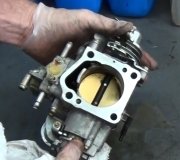I should have added, if that idle speed motor isn't able to turn freely to adjust the air valve, the computer will still THINK it's adjusting it. It will keep bringing the number of steps down all the way to "0" in hopes of getting the idle speed down. No diagnostic fault code related to the motor will be set in memory because electrically, there is nothing wrong. That's what the computer checks for.
Oops. I just checked the code descriptions for myself and got "35 - idle air control sensor circuit fault". I see where some people get confused with the operation of that motor because it is not a "sensor" which is a computer input. It's a computer output. The fact it's setting a code suggests an electrical problem.
That motor has four wires going to it and four electromagnetic coils between them inside. Pulsing those coils with varying voltage and polarity is what slowly turns, or "steps" the armature of the motor to various settings. If any one of those coils is open, (has a break in it), or if any one of the wires going to it is open, or if any one of the connector pins is stretched or corroded, the motor won't turn.
There really isn't an easy, fast way to check the wiring except by removing the plug from the computer and doing resistance checks. You can't test anything with a voltmeter either. Since there isn't much to check, the best approach is to physically check the pins in the connector, and while it's unplugged, measure for continuity between all four pins on the motor. I have no clue what the normal resistance should be. All I would care about is none of them are open. To add to the confusion, if one of the four coils is open, you'll still measure continuity between all of the pins by measuring through all of the other coils. I don't think the computer will even detect one open coil. For an open to be detected, it would probably have to be a break in the wire harness going to the motor, not in the motor itself. As a result, substituting a new or known good motor is a faster way of finding a bad one, but be careful with the two mounting bolts. They're usually torx heads that strip and round out very easily, and to help that happen there is thread lock sealant on the bolt threads. Often it's hard to get squarely on the bolts too. Be sure to use the proper size torx bit with plenty of force to keep it straight and engaged in the head.
Another way of inspecting the idle speed motor is to unbolt it, pull really hard on the valve to extend it, then reinstall it that way. That will block the idle air passage and cause a really low idle speed. If the circuit is working properly, that valve will retract when the ignition switch is turned on, (Chryslers), or when the engine is stopped, (GMs), in preparation for the next engine start-up. (I might have the GM version backward; it might be the same as the Chrysler operation. The difference is you can usually hear that motor running right after the engine is stopped on many GM trucks). Regardless of when that valve moves, if it's working properly, you will get a nice idle "flareup" to 1500 rpm for a few seconds right after starting the engine, then it will drop right back to the normal 800 or so rpm. If it does that, the motor is working, the computer has control of it, and the air passage is not blocked with carbon.
Friday, December 9th, 2011 AT 10:38 PM



